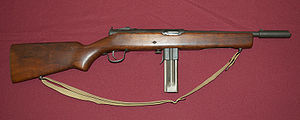This article has multiple issues. Please help improve it or discuss these issues on the talk page. (Learn how and when to remove these messages)
|
| Reising Model 50 | |
|---|---|
 The Reising Model 50 submachine gun | |
| Type | Submachine gun |
| Place of origin | United States |
| Service history | |
| In service | 1941–1975 |
| Used by | See Users |
| Wars | World War II Hukbalahap Rebellion Malayan Emergency[1] Calderonista invasion of Costa Rica[1] Vietnam War[2] Dominican Civil War[1] |
| Production history | |
| Designer | Eugene Reising |
| Designed | 1940 |
| Manufacturer | Harrington & Richardson |
| Produced | 1941–1945 |
| Variants | M50, M55, M60 |
| Specifications | |
| Mass | 3.1 kg (6.83 lb) (M50) 2.8 kg (6.2 lb) (M55) |
| Length | 895.35 mm (35.250 in) 565.15 mm (22.3 in) stock retracted (M55) |
| Barrel length | 279 mm (11.0 in) (M50) |
| Cartridge | .45 ACP (M50, M55, M60)[3] .22 LR (M65) |
| Action | Delayed blowback, closed bolt |
| Rate of fire | 550 rounds/min (M50) 500 rounds/min (M55) |
| Muzzle velocity | 280 m/s (919 ft/s) |
| Maximum firing range | 274 m (300 yards) |
| Feed system | 12- or 20-round detachable box magazine, 30-round aftermarket detachable box magazine |
| Sights | Front blade, rear notch |
The .45 Reising submachine gun was manufactured by Harrington & Richardson (H&R) Arms Company in Worcester, Massachusetts, USA, and was designed and patented by Eugene Reising in 1940. The three versions of the weapon were the Model 50, the folding stock Model 55, and the semiautomatic Model 60 rifle.[4] Over 100,000 Reisings were ordered during World War II, and were initially used by the United States Navy, Marine Corps, and the United States Coast Guard, though some were shipped to Canadian, Soviet, and other allied forces to fight the Axis powers.[5]
- ^ a b c Cite error: The named reference
SGWwas invoked but never defined (see the help page). - ^ Dockery, Kevin (December 2004). Weapons of the Navy SEALs. New York City: Berkley Publishing Group. p. 382. ISBN 0-425-19834-0.
- ^ "Latest Submachine Gun is Designed for Mass Production". Popular Science (April): 73–77. 1941.
- ^ Robert C. Ankony, "The US .45 Model 50 and 55 Reising submachine gun and Model 60 Semiautomatic Rifle," Small Arms Review, Jul.2008.
- ^ Thomas B. Nelson, The World's Submachine Guns, TBN Enterprises, 1963